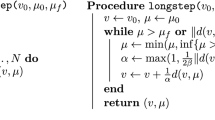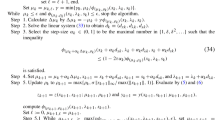Abstract
We present a logarithmic barrier interior-point method for solving a second-order cone programming problem. Newton’s method is used to compute the descent direction. The main contribution of this paper is that it uniquely uses the so-called majorant functions as an efficient alternative to line search methods to determine the displacement step along the direction while solving second-order cone programs. The efficiency of our method is shown by presenting numerical experiments.
Similar content being viewed by others
References
Benterki, D., Crouzeix, J.P., Merikhi, B.: A numerical feasible interior point method for linear semidefinite programs. RAIRO Oper. Res. 41, 49–59 (2007)
Touil, I., Benterki, D., Yassine, A.: A feasible primal-dual interior point method for linear semidefinite programming. J. Comput. Appl. Math. 312, 216–230 (2017)
Mennichea, L., Benterki, D.: A logarithmic barrier approach for linear programming. J. Comput. Appl. Math. 312, 267–275 (2017)
Crouzeix, J.P., Merikhi, B.: A logarithm barrier method for semidefinite programming. RAIRO Oper. Res. 42, 123–139 (2008)
Alzalg, Baha, Pirhaji, M.: Elliptic cone optimization and primal-dual path-following algorithms. Optimization 66, 2245–2274 (2017)
Alzalg, Baha, Pirhaji, M.: Primal-dual path-following algorithms for circular programming. Commun. Comb. Optim. 2, 65–85 (2017)
Wright, S.: Primal-Dual Interior Point Methods. SIAM, Philadelphia (1997)
Hertog, D.: Interior-Point Approach to Linear Quadratic and Convex Programming. Kluwer, Dordrecht (1994)
Nestrov, Y.E., Nemiroveskii, A.: Interior Point Polynomial Algorithms in Convex Programming. SIAM, Philadelphia (1994)
Roos, C., Terlaky, T., Vial, J.P.: Theory and Algorithms for Linear Optimization: An Interior-Point Approach. Wiley, Hoboken (1997)
Ye, Y.: Interior Point Algorithms: Theory and Analysis. In: Wiley-Interscience Series in Discrete Mathematics Optimization. Wiley, New York (1997)
Kebbiche, Z., Keraghel, A., Yassine, A.: Extension of a projective interior point method for linearly constrained convex programming. Appl. Math. Comput. 193, 553–559 (2007)
Naseri, R., Valinejad, A.: An extended variant of Karmarkar’s interior point algorithm. Appl. Math. Comput. 184, 737–742 (2007)
Achache, M.: A weighted path-following method for the linear complementarity problem. Studia Univ. Babes-Bolyai Ser. Inform. 48, 61–73 (2004)
Darvay, Z.: A weighted-path-following method for linear optimization. Studia Univ. Babes-Bolyai Ser. Inform. 47, 3–12 (2002)
Alizadeh, F., Haberly, J.-P., Overton, M.-L.: Primal-dual interior-point methods for semidefinite programming, convergence rates, stability and numerical results. SIAM J. Optim. 8, 746–768 (1998)
Benterki, D., Crouzeix, J.-P., Merikhi, B.: A numerical implementation of an interior point method for semi-definite programming. Pesquisa Operacional 23, 49–59 (2003)
Tang, J., He, G., Dong, L., Fang, L., Zhou, J.: A globally and quadratically convergent smoothing Newton method for solving second-order cone optimization. Appl. Math. Model. 39, 2180–2193 (2015)
Dong, L., Tang, J., Zhou, J.: A smoothing Newton algorithm for solving the monotone second-order cone complementarity problems. J. Appl. Math. Comput. 40, 45–61 (2012)
Chi, X., Liu, S.: A new one-step smoothing Newton method for second-order cone programming. J. Comput. Appl. Math. 223, 114–123 (2009)
Tang, J., He, G., Dong, L., Fang, L.: A smoothing Newton method for second-order cone optimization based on a new smoothing function. Appl. Math. Comput. 218, 1317–1329 (2011)
Fang, L.: A smoothing-type Newton method for second-order cone programming problems based on a new smooth function. J. Appl. Math. Comput. 34, 147–161 (2010)
Alizadeh, F., Goldfarb, D.: Second-order cone programming. Math. Program. Ser. B 95, 3–51 (2003)
Hans, Y.-J., Mittelmann, D.: Interior point methods for second-order cone programming and OR applications. Comput. Optim. Appl. 28, 255–285 (2004)
Kheirfam, B.: A corrector-predictor path-following method for second-order cone optimization. Int. J. Computer Math. 93, 2064–2078 (2016)
Hao, Z., Wan, Z., Chi, X., Chen, J.: A power penalty method for second-order cone nonlinear complementarity problems. J. Comput. Appl. Math. 290, 136–149 (2015)
Auslender, A.: An exact penalty method for nonconvex problems covering, in particular, nonlinear programming, semidefinite programming, and second-order cone programming. SIAM J. Optim. 25, 1732–1759 (2015)
Faraut, J., Korányi, A.: Analysis on Symmetric Cones. Oxford University Press, Oxford (1994)
Wolkowicz, H., Styan, G.-P.-H.: Bounds for eigenvalues using traces. Linear Algebra Appl. 29, 471–506 (1980)
Tang, J., He, G., Dong, L., Fang, L.: A new one-step smoothing newton method for second-order cone programming. Appl. Math. 57, 311–331 (2012)
Schmieta, S.H., Alizadeh, F.: Extension of primal-dual interior point methods to symmetric cones. Math. Program. Ser. A 96, 409–438 (2003)
MOSEK is an optimization software designed to solve large-scale mathematical optimization problems. http://www.mosek.com/
Acknowledgements
The work of the author was supported in part by the Deanship of Scientific Research at The University of Jordan. The author thanks the anonymous referees for their valuable suggestions, their constructive comments have greatly enhanced the paper.
Author information
Authors and Affiliations
Corresponding author
Ethics declarations
Conflict of interest
The authors declare that they have no conflict of interest.
Data statement
Due to the sensitive nature of the data, we are not in a position to share data as we do not have permission to do so.
Additional information
Publisher's Note
Springer Nature remains neutral with regard to jurisdictional claims in published maps and institutional affiliations.
Rights and permissions
About this article
Cite this article
Alzalg, B. A logarithmic barrier interior-point method based on majorant functions for second-order cone programming. Optim Lett 14, 729–746 (2020). https://doi.org/10.1007/s11590-019-01404-1
Received:
Accepted:
Published:
Issue Date:
DOI: https://doi.org/10.1007/s11590-019-01404-1




